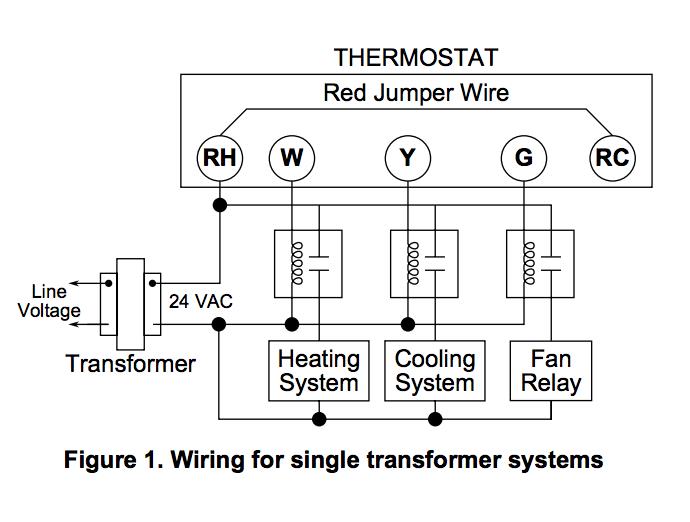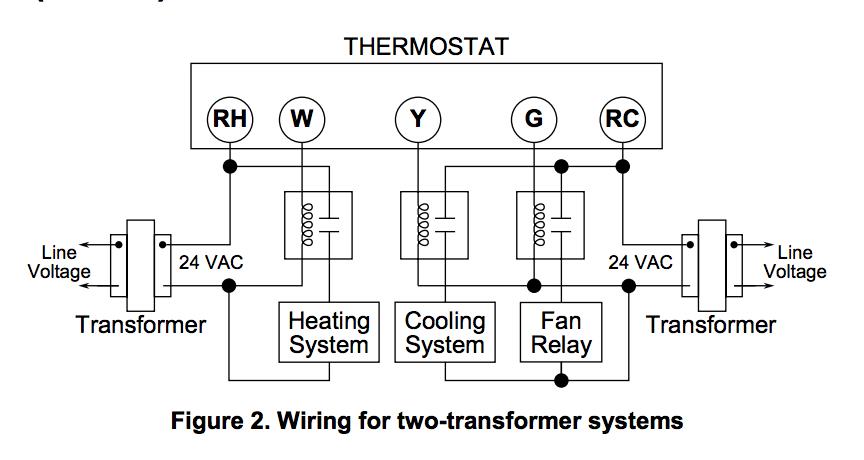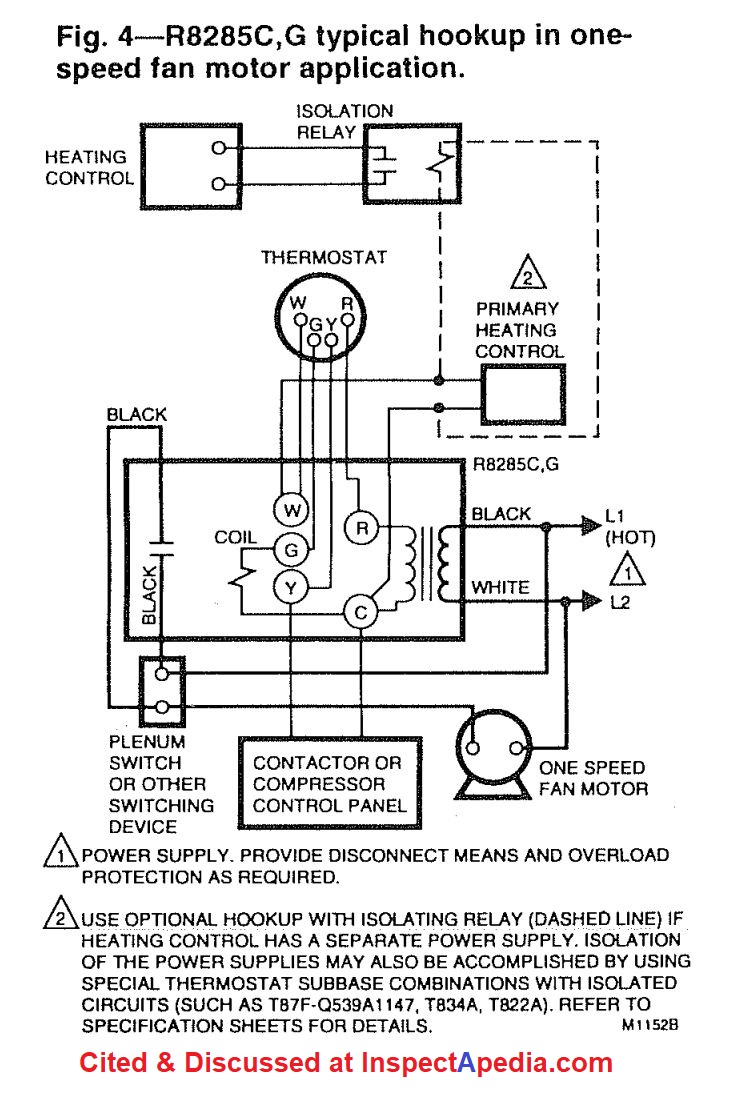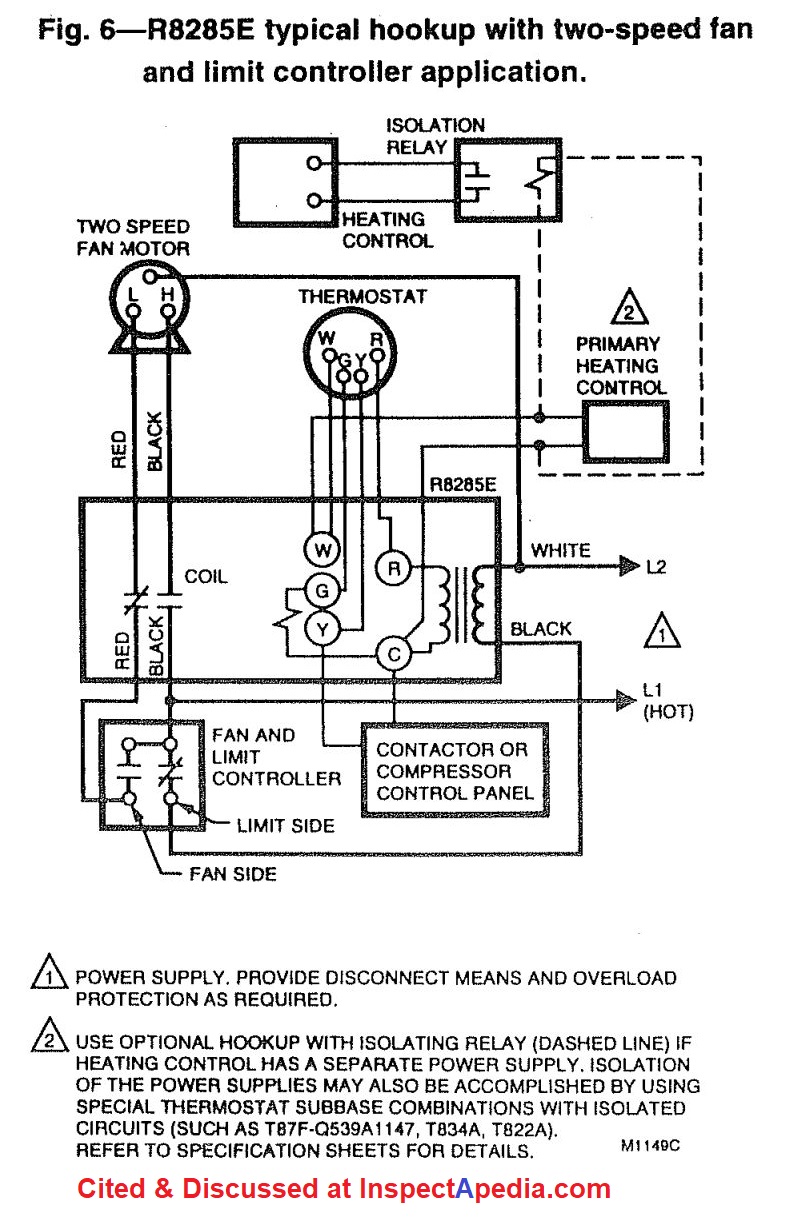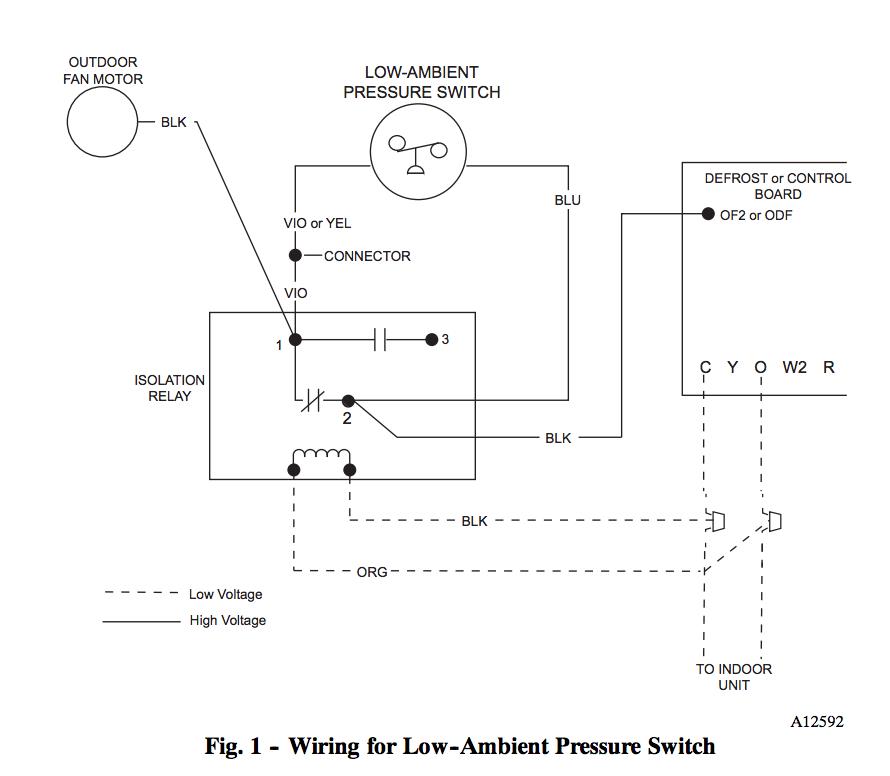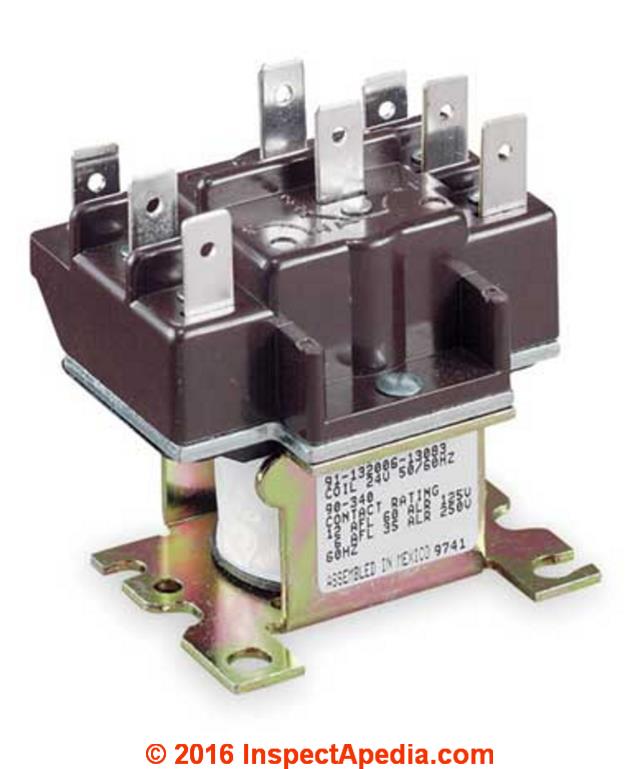 Isolation Relay Control Switch Wiring
Isolation Relay Control Switch Wiring
Furnace / Control Relay Isolation Switches, eg. White Rodgers 90-340
- POST a QUESTION or COMMENT about wiring HVAC controls, the furnace blower fan limit switch and about the manual "fan on" or blower fan override switch.
Isolation switch purpose, wiring, use:
What is an isolation relay or isolation switch used in heating or cooling systems & how is the relay wired? An isolation switch allows a low voltage (e.g. 24VAC) circuit such as a thermostat to control higher-voltage equipment such as electric heaters and the blower in an electric furnace.
Shown above: White Rodgers 90-340 24VAC Relay switch, model 90-340. This article series describes in detail the wiring & setting of HVACR controls and answers most questions about central heating system troubleshooting, inspection, diagnosis, and repairs. We describe how to inspect, troubleshoot and repair heating and air conditioning systems to inform home owners, buyers, and home inspectors of common heating system defects.
InspectAPedia tolerates no conflicts of interest. We have no relationship with advertisers, products, or services discussed at this website.
- Daniel Friedman, Publisher/Editor/Author - See WHO ARE WE?
Wiring the Isolation Relay on an Electric Furnace
 Tips for wiring the Isolation Relay on my electric furnace heating system
Tips for wiring the Isolation Relay on my electric furnace heating system
An InspectApedia reader asked us:
I have older electric furnace with heat and ac. I replaced the sequencers last year and the fan isolation relay last week. the wiring was suspect before the repairs, I had to rewire the 24 volt wiring.
The only wire now I am wondering about is the 240v wire from the heat sequencer to the isolation relay.
The only problem I have is: only the high speed fan runs. the low speed fan does not run when heat is on, it continues to run the high speed fan. this is is fan auto and fan on. What is the proper wiring from sequencer to fan isolation relay to have low speed fan for heat? I have high speed for ac and fan on as wired.
This question was originally posted at FAN LIMIT CONTROL SETTINGS 2016/09/16 Bob
Reply:
Bob, sorry to have to be less than helpful but I think that considering the risks involved, what's needed is to identify the furnace brand and model, then pick up the wiring diagram. If you have that we need to identify the terminals on the isolation relay to be able to specify the wiring.
Above and at page top I'm showing two White Rodgers isolation switch control relays; the second one purports to be the isolation switch you have.
Reader follow-up:
Bob said:
Thanks . I do have the wiring diagram of the original furnace (wesco 1980 era).
The unit was retrofitted with trane AC in 1998 so the wiring must have been modified at that time. the original diagram had only high speed wired up to a switch, did not have the isolation relay and only had red and white thermostat wires. the isolation relay is a 91-132006-13302 with 24v pair of connections and two 240v switch connections, 240 is connected to the bottom of the first switch with the high speed wire connected to the top.
The low speed wire is connected to the second switch with a 240 wire from the top of the sequencer sack to the center pole on the second switch.
This is as close as I can describe since the unit was retrofitted.
Moderator reply:
For other readers: an Isolation Relay is simply an electrical control that isolates different voltages in an HVACR application, so that, for example, a 24VAC thermostat can control 120VAC or 240VAC powered cooling or heating equipment. Some isolation relays also support multiple switching such as multiple speed fans.
Bob:
Do you think the blower fan is a model capable of multiple speeds but the controller is designed for only one speed? If that's the case, by adding a toggle switch you might be able to switch the existing single fan-on wire to swap manually between the two fan speeds.
I think the relay you cite is a 12 V White-Rodgers-rbm-91132009113200690340 isolation relay.
I found these White Rodgers 1F90 / 1F97 isolation relay wiring diagrams that might help. Click to enlarge any image:
- White Rodgers 1F90 / 1F97 Installation Instructions Addendum [PDF] retrieved 2016/09/16, original source: www.emersonclimate.com/en-US/resources/faq/white_rodgers/Documents/0037-5426.pdf
I don't know much about the White Rodgers isolation relay, but if it helps sort out the fan speed question, Honeywell's R8285 is sold in different models that support just 1 vs multi fan speeds. Those instructions show the position and wiring for the isolation relay too. In a 2-speed fan operation with this control the fan runs in low speed until there is a call for heat, then the fan speeds up.
- Honeywell R8258A-G,J,K CONTROL CENTRER WIRING - isolation relay [PDF] retrieved 2016/09/16, also referred to as a transformer relay, original source:
store.dakacorp.com/v/vspfiles/documents/Honeywell%20Transformer%20Relay%20R8285A%20Instructions.pdf
Also see these instructions illustrated below:
- KHAIR0201AAA Isolation Relay Kit Installation Instructions, [PDF],CAC / BDP D 7310 W. Morris St. D Indianapolis, IN 46231, (2011) retrieved 2016/09/16, original source: dms.hvacpartners.com/docs/1009/public/0e/iik-khair-01.pdf
...
Reader Comments, Questions & Answers About The Article Above
Below you will find questions and answers previously posted on this page at its page bottom reader comment box.
Reader Q&A - also see RECOMMENDED ARTICLES & FAQs
How to wire double-pole double throw relay switch in a circuit
..., your comments helped me with a search string that found this link:
- Learning about Electronics, "How to Connect a DPDT Relay in a Circuit [Web Page], Website: http://www.learningaboutelectronics.com/ Email: support@learningaboutelectronics.com Original source: www.learningaboutelectronics.com/Articles/How-to-connect-a-double-pole-double-throw-relay-in-a-circuit
It shows the circuits on the relay I have. My blower does have a multi speed motor with 3 speeds of which I am using two. I will study the link above and see if I can figure out how to activate low speed for heat. I am currently wired up as specified in my previous message, this link should allow me to determine if I can change it or not. I'll let you know after I study it.
Mod reply: The article shows a 12-volt relay (or in some systems other voltage such as 24VAC) used to switch higher voltage circuits. The user needs to identify each terminal for proper wiring; usually they're stamped or marked on the relay case:
- Coil terminal - a 12V circuit that closes a relay that closes (or opens) the switch
- NO - a switch that is Normally Open (or "off") - this switches a 120V (or higher voltage depending on the switch and application) device "ON" when the relay is powered and closes
- NC - this is a Normally Closed (or "on") switch. This switch in your application would run a low speed fan, if used. The switch will open (turn "OFF") when the relay is powered and closes
- COM - identified as the common wire for the relay; the relay may have different voltage outputs on different COM wires or terminals. Some relays such as the one in this example have eight terminals, sporting two of each of the types listed here.
2016/09/18 Bob
Reader follow-up: thermostat white & green wires not acting as expected: why heat would not turn on low speed blower but left high speed blower running.
Final resolution of my fan isolation relay / fan speed issue. Having reviewed the above links on the isolation relay, I can confirm my heating and cooling are properly connected to the relay's terminals.
Having confirmed that, I tested the thermostat wires again to see why heat would not turn on low speed blower but left high speed blower running.
I found, to my surprise, that the thermostat heats up the green fan wire at the same time it heats up the white heat wire.
(I thought the white wire hot would leave green cold and the sequencer would turn on the low speed blower.)
Also, I thought green would only be hot if I used fan on the thermostat).
With green wire hot during heat cycle, the relay keeps the hot wire from the sequencer from connecting to the low speed terminal. So problem, solved, I know why low heat doesn't activate.
My solution to this will be to add an additional isolation relay between the heat and fan only to achieve low speed blower on heat, high speed blower on fan only and high speed blower on cool. Thanks for all your help.
I added this conclusion to share how these isolation switches work and can help solve problems. 2016/09/18 Bob
Moderator reply:
Good going, Bob. This diagnosis will surely help other readers working on thermostat wiring or isolation relay wiring problems. Thanks so much for taking the time to follow-up.
PS: before adding another isolation relay, I'd double check that the white and green wires are not shorted together anywhere enroute. Disconnect the wires at both ends of their circuit and then check them for continuity. - Ed.
Question: operating the limit switch FAN ON switch
My fan limit control says push man and an arrow, no white button, only an empty hole. What should I do? I set the numbers at their correct positions but the blower still remains on for a while and then comes back on after going off.
I was lucky enough to replace my blower motor on my own after ordering it online. NO HELP FROM ANY MEN! The least of my worries was the fan limiter. Now after a month of heat I need help! Thank you (Jan 31, 2014) marie
Reply:
If your limit control has no actual operable push-pull button or switch, then it's a model that omitted that feature. The switch will still work automatically. The manual switch is an extra, not mandatory.
Watch out: Be careful not to mess with, force, or bend the switch parts - doing so could make it unsafe.
Question: olsen ultramax furnace NG that clicks on for 3 seconds
I have an olsen ultramax furnace NG that clicks on for 3 seconds off on for 4 seconds 3rd time kicks in to running. going to change the pilot assembly kit, hope that's all. runs a lot. put in a new thermostat already. hope to hear from you. norm (Mar 5, 2014) norm williams
Reply:
Norm,
I don't blame you for thinking about the pilot assembly as it sounds as if the unit has trouble starting.Keep in mind that dirt or debris at the igniter or pilot could be the problem, as could a sensor, or at the thermocouple itself. Often by watching the flame at start up we can figure out what's going on. For example if a the pilot lights but then goes out I suspect that a thermocouple is bad.
Question: Does the Honeywell fan and limit control have any part in controlling the fan in a/c operation
Does the Honeywell fan and limit control have any part in controlling the fan in a/c operation or is that done strictly by the fan relay and thermostat?
I just installed a new fan and limit control ion my furnace and the blower continues to run for 10 minutes after the a/c condenser shuts off? (Sept 22, 2014) JT
Reply: no but ...
JT
The fan limit switch is a heating control and does not work during cooling
except
if someone puts the switch in manual FAN ON position then the blower fan will simply keep running.
Question: replacement fan limit switch L4064w1296 19538c
I need a replacement fan limit switch L4064w1296 19538c. It is no longer listed. I am using a dual energy system (oil/electricity)at my choice. Where can I get a replacement ? (May 27, 2015) Ron
Reply:
A check with the manufacturer of your heating furnace and with your heating service technician should confirm that you can use one of the more generic fan limit switches.
hn. Give us the model and serial number and we can perhaps locate the manual for you.
...
Continue reading at FAN LIMIT SWITCH - topic home, or select a topic from the closely-related articles below, or see the complete ARTICLE INDEX.
Or see these
Recommended Articles
- AIR HANDLER / BLOWER UNITS - home
- BLOWER FAN OPERATION & TESTING if your heating or cooling system blower fan itself appears not to be working,
- BLOWER FAN SPEED SETTINGS- how to set the air handler fan speed
- FAN LIMIT SWITCH TROUBLESHOOTING
- FURNACES, HEATING - home
Suggested citation for this web page
ISOLATION SWITCH WIRING at InspectApedia.com - online encyclopedia of building & environmental inspection, testing, diagnosis, repair, & problem prevention advice.
Or see this
INDEX to RELATED ARTICLES: ARTICLE INDEX to HEATING FURNACES
Or use the SEARCH BOX found below to Ask a Question or Search InspectApedia
Ask a Question or Search InspectApedia
Try the search box just below, or if you prefer, post a question or comment in the Comments box below and we will respond promptly.
Search the InspectApedia website
Note: appearance of your Comment below may be delayed: if your comment contains an image, photograph, web link, or text that looks to the software as if it might be a web link, your posting will appear after it has been approved by a moderator. Apologies for the delay.
Only one image can be added per comment but you can post as many comments, and therefore images, as you like.
You will not receive a notification when a response to your question has been posted.
Please bookmark this page to make it easy for you to check back for our response.
IF above you see "Comment Form is loading comments..." then COMMENT BOX - countable.ca / bawkbox.com IS NOT WORKING.
In any case you are welcome to send an email directly to us at InspectApedia.com at editor@inspectApedia.com
We'll reply to you directly. Please help us help you by noting, in your email, the URL of the InspectApedia page where you wanted to comment.
Citations & References
In addition to any citations in the article above, a full list is available on request.
- Honeywell Corporation, Minneapolis, MN 55408. Honeywell has sales offices in all principal cities in the world and has manufacturing facilities in Australia, Canada, Finland, France, Germany, Japan, Mexico, Netherlands, Spain, Taiwan, United Kingdom, U.S.A. Honeywell Form Number 60-0450 7-75, residential division. Honeywell's latest product data for this type of control can be found in English at http://customer.honeywell.com/Techlit/Pdf/69-0000s/69-0117.pdf
- Our recommended books about building & mechanical systems design, inspection, problem diagnosis, and repair, and about indoor environment and IAQ testing, diagnosis, and cleanup are at the InspectAPedia Bookstore. Also see our Book Reviews - InspectAPedia.
- In addition to citations & references found in this article, see the research citations given at the end of the related articles found at our suggested
CONTINUE READING or RECOMMENDED ARTICLES.
- Carson, Dunlop & Associates Ltd., 120 Carlton Street Suite 407, Toronto ON M5A 4K2. Tel: (416) 964-9415 1-800-268-7070 Email: info@carsondunlop.com. Alan Carson is a past president of ASHI, the American Society of Home Inspectors.
Thanks to Alan Carson and Bob Dunlop, for permission for InspectAPedia to use text excerpts from The HOME REFERENCE BOOK - the Encyclopedia of Homes and to use illustrations from The ILLUSTRATED HOME .
Carson Dunlop Associates provides extensive home inspection education and report writing material. In gratitude we provide links to tsome Carson Dunlop Associates products and services.


